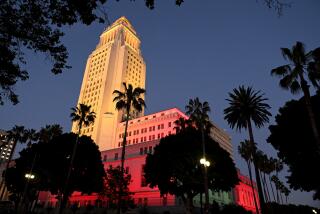For Garcia, Going From Planner to Lobbyist Was Easy
- Share via
Daniel P. Garcia, former president of the Los Angeles City Planning Commission, was explaining why he became a land development lawyer-lobbyist--one of the most successful at City Hall.
“When I had my heart attack or whatever it was, I was in the hospital,” he said. “It occurred to me that leading the two lives of doing litigation on the one hand and running the Planning Commission was too much.
“It had taken too big a personal toll. I had already gone through two divorces and I was in the hospital, overweight, smoking, eating too much. This was not what I wanted to do.”
Garcia, a partner in the downtown Los Angeles firm of Munger, Tolles & Olson, is representing the Porter Ranch Development Co. in its effort to win city permission to build a huge residential and commercial subdivision on 1,300 acres in the far northwest San Fernando Valley.
He is one of several former top city officials who have gone through what critics consider a “revolving door,” moving from public life into lobbying or consulting for clients with business before the city.
Porter Ranch Development Co. is also represented by former City Councilman Robert Wilkinson, who once represented the district where the big subdivisions would be built.
And in another City Hall link, Porter Ranch has also hired as a consultant Paul Clarke, who has been a top political adviser to the current councilman, Hal Bernson, and also is a close personal friend. That is part of another City Hall pattern: Developers and others with business before the council often hire lobbyists or consultants with close ties to certain council members.
The emergence of Garcia as a land development attorney had a major impact because, as Planning Commission president, he was one of the most influential men in city government.
The planning commissioners are part-timers, paid a nominal amount for their work. But Garcia, with a love for detail, politics and power, extended his influence beyond the commission.
He worked with staff members in the writing of zoning laws and community plans. He was a close adviser to Mayor Tom Bradley, who had appointed him, and he influenced mayoral policy.
Garcia did his work with a point of view--moderately pro-development, walking a line between slow-growthers, of whom he disapproved, and those committed to unbridled development.
His opposition to the slow-growth movement stemmed, in part, from his Latino background. A ban on building, he said, would cost jobs, limit housing opportunity and cause social tension between the working class and the wealthy.
In addition to Porter Ranch Development Co., Garcia has other big business clients, including May Centers; Ratovich Co., a major developer and restorer of historic buildings; Price Co., the big discount firm; and Harvey Capitol Co.
His clients have been major players in city politics over the years. Since 1982, eight of his clients have donated $226,163 to city political candidates.
Did his years in City Hall give him special influence with the mayor, the council and members of the Planning Department staff?
“Lots of people have access to the mayor,” he said. “I would say I have good access, but I don’t think it is distinguishable (from that of others). The fact that I was in city government--does that account for that access, in part? Yes, of course.”
“Nobody approves any projects simply because of me, and Porter Ranch is a good example. I haven’t lobbied anyone on Porter Ranch. I’m not the lobbyist on Porter Ranch. They’ve got Wilkinson and I assume (developer Nathan) Shapell is talking to people.”
Although Garcia said he does not lobby council members, he has written strong legal and planning arguments defending the Porter Ranch project’s effect on schools and on regional planning aspects of the development.
More to Read
Sign up for Essential California
The most important California stories and recommendations in your inbox every morning.
You may occasionally receive promotional content from the Los Angeles Times.













